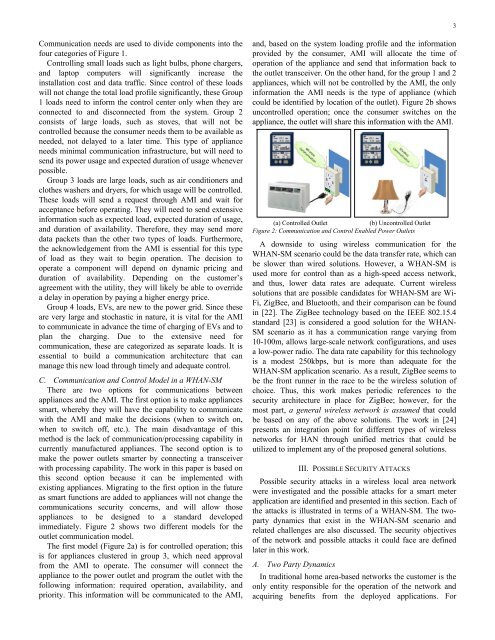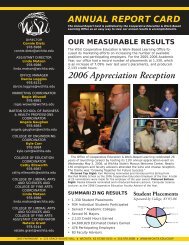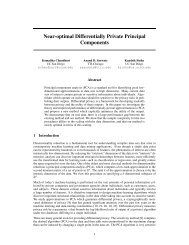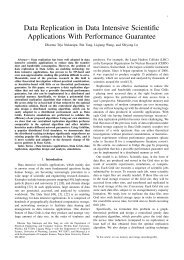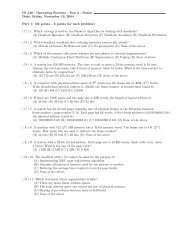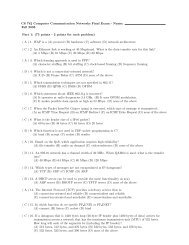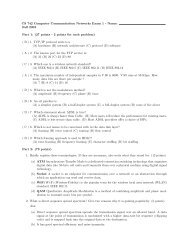Wireless AMI Application and Security for Controlled Home Area ...
Wireless AMI Application and Security for Controlled Home Area ...
Wireless AMI Application and Security for Controlled Home Area ...
Create successful ePaper yourself
Turn your PDF publications into a flip-book with our unique Google optimized e-Paper software.
3Communication needs are used to divide components into thefour categories of Figure 1.Controlling small loads such as light bulbs, phone chargers,<strong>and</strong> laptop computers will significantly increase theinstallation cost <strong>and</strong> data traffic. Since control of these loadswill not change the total load profile significantly, these Group1 loads need to in<strong>for</strong>m the control center only when they areconnected to <strong>and</strong> disconnected from the system. Group 2consists of large loads, such as stoves, that will not becontrolled because the consumer needs them to be available asneeded, not delayed to a later time. This type of applianceneeds minimal communication infrastructure, but will need tosend its power usage <strong>and</strong> expected duration of usage wheneverpossible.Group 3 loads are large loads, such as air conditioners <strong>and</strong>clothes washers <strong>and</strong> dryers, <strong>for</strong> which usage will be controlled.These loads will send a request through <strong>AMI</strong> <strong>and</strong> wait <strong>for</strong>acceptance be<strong>for</strong>e operating. They will need to send extensivein<strong>for</strong>mation such as expected load, expected duration of usage,<strong>and</strong> duration of availability. There<strong>for</strong>e, they may send moredata packets than the other two types of loads. Furthermore,the acknowledgement from the <strong>AMI</strong> is essential <strong>for</strong> this typeof load as they wait to begin operation. The decision tooperate a component will depend on dynamic pricing <strong>and</strong>duration of availability. Depending on the customer’sagreement with the utility, they will likely be able to overridea delay in operation by paying a higher energy price.Group 4 loads, EVs, are new to the power grid. Since theseare very large <strong>and</strong> stochastic in nature, it is vital <strong>for</strong> the <strong>AMI</strong>to communicate in advance the time of charging of EVs <strong>and</strong> toplan the charging. Due to the extensive need <strong>for</strong>communication, these are categorized as separate loads. It isessential to build a communication architecture that canmanage this new load through timely <strong>and</strong> adequate control.C. Communication <strong>and</strong> Control Model in a WHAN-SMThere are two options <strong>for</strong> communications betweenappliances <strong>and</strong> the <strong>AMI</strong>. The first option is to make appliancessmart, whereby they will have the capability to communicatewith the <strong>AMI</strong> <strong>and</strong> make the decisions (when to switch on,when to switch off, etc.). The main disadvantage of thismethod is the lack of communication/processing capability incurrently manufactured appliances. The second option is tomake the power outlets smarter by connecting a transceiverwith processing capability. The work in this paper is based onthis second option because it can be implemented withexisting appliances. Migrating to the first option in the futureas smart functions are added to appliances will not change thecommunications security concerns, <strong>and</strong> will allow thoseappliances to be designed to a st<strong>and</strong>ard developedimmediately. Figure 2 shows two different models <strong>for</strong> theoutlet communication model.The first model (Figure 2a) is <strong>for</strong> controlled operation; thisis <strong>for</strong> appliances clustered in group 3, which need approvalfrom the <strong>AMI</strong> to operate. The consumer will connect theappliance to the power outlet <strong>and</strong> program the outlet with thefollowing in<strong>for</strong>mation: required operation, availability, <strong>and</strong>priority. This in<strong>for</strong>mation will be communicated to the <strong>AMI</strong>,<strong>and</strong>, based on the system loading profile <strong>and</strong> the in<strong>for</strong>mationprovided by the consumer, <strong>AMI</strong> will allocate the time ofoperation of the appliance <strong>and</strong> send that in<strong>for</strong>mation back tothe outlet transceiver. On the other h<strong>and</strong>, <strong>for</strong> the group 1 <strong>and</strong> 2appliances, which will not be controlled by the <strong>AMI</strong>, the onlyin<strong>for</strong>mation the <strong>AMI</strong> needs is the type of appliance (whichcould be identified by location of the outlet). Figure 2b showsuncontrolled operation; once the consumer switches on theappliance, the outlet will share this in<strong>for</strong>mation with the <strong>AMI</strong>.(a) <strong>Controlled</strong> Outlet(b) Uncontrolled OutletFigure 2: Communication <strong>and</strong> Control Enabled Power OutletsA downside to using wireless communication <strong>for</strong> theWHAN-SM scenario could be the data transfer rate, which canbe slower than wired solutions. However, a WHAN-SM isused more <strong>for</strong> control than as a high-speed access network,<strong>and</strong> thus, lower data rates are adequate. Current wirelesssolutions that are possible c<strong>and</strong>idates <strong>for</strong> WHAN-SM are Wi-Fi, ZigBee, <strong>and</strong> Bluetooth, <strong>and</strong> their comparison can be foundin [22]. The ZigBee technology based on the IEEE 802.15.4st<strong>and</strong>ard [23] is considered a good solution <strong>for</strong> the WHAN-SM scenario as it has a communication range varying from10-100m, allows large-scale network configurations, <strong>and</strong> usesa low-power radio. The data rate capability <strong>for</strong> this technologyis a modest 250kbps, but is more than adequate <strong>for</strong> theWHAN-SM application scenario. As a result, ZigBee seems tobe the front runner in the race to be the wireless solution ofchoice. Thus, this work makes periodic references to thesecurity architecture in place <strong>for</strong> ZigBee; however, <strong>for</strong> themost part, a general wireless network is assumed that couldbe based on any of the above solutions. The work in [24]presents an integration point <strong>for</strong> different types of wirelessnetworks <strong>for</strong> HAN through unified metrics that could beutilized to implement any of the proposed general solutions.III. POSSIBLE SECURITY ATTACKSPossible security attacks in a wireless local area networkwere investigated <strong>and</strong> the possible attacks <strong>for</strong> a smart meterapplication are identified <strong>and</strong> presented in this section. Each ofthe attacks is illustrated in terms of a WHAN-SM. The twopartydynamics that exist in the WHAN-SM scenario <strong>and</strong>related challenges are also discussed. The security objectivesof the network <strong>and</strong> possible attacks it could face are definedlater in this work.A. Two Party DynamicsIn traditional home area-based networks the customer is theonly entity responsible <strong>for</strong> the operation of the network <strong>and</strong>acquiring benefits from the deployed applications. For


